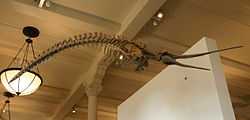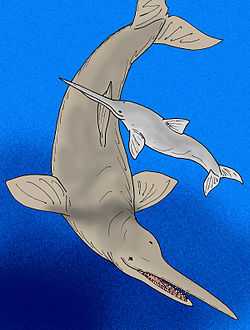Eurhinodelphis
| Eurhinodelphis Temporal range: Middle Miocene–Late Miocene | |
|---|---|
 | |
| Skeleton of E. longirostris | |
| Scientific classification | |
| Kingdom: | Animalia |
| Phylum: | Chordata |
| Class: | Mammalia |
| Order: | Cetacea |
| Suborder: | Odontoceti |
| Family: | †Eurhinodelphinidae |
| Genus: | Eurhinodelphis Du Bus, 1867 |
| Species | |
| |
Eurhinodelphis ("well-nosed dolphin") is an extinct genus of Miocene cetacean. Its fossils have been found in France, Belgium, Maryland and California.
Description

Eurhinodelphis was around 2 metres (6.6 ft) in length. In most respects, it would have looked like a modern dolphin or porpoise, but its upper jaw was elongated into a sharp tip similar to that of a swordfish. Most likely, Eurhinodelphis used it in a similar manner to swordfish, hitting or stabbing prey. It also had long, sharp teeth.[1]
Compared with earlier fossil species, Eurhinodelphis had complex ears, suggesting that it already hunted by echolocation like modern whales. Its brain was also asymmetrical, a trait found in modern dolphins, and possibly associated with the complexities of navigating its environment.[1]
Eurhinodelphis was closely related to the orca-sized Macrodelphinus.
History
Eurhinodelphis was first described by B. Du Bus in a paper read before the Royal Academy of Sciences of Belgium on 17 December, 1867. O. Abel studied and illustrated the European species in a series of articles published in 1901, 1902 and 1905; subsequently, fossil skulls found in the Calvert Formation in Maryland and Virginia could be attributed to this genus.